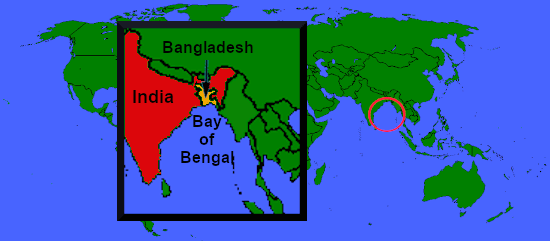
Circle the area on this map

C. They are all tropical storms with maximum sustained winds of 74 mph or more. But, they are known by different names in different locations. In the North Atlantic Ocean and Northeast Pacific, they are called hurricanes. In the Northwest Pacific Ocean they are typhoons, and they are called cyclones in the South Pacific and Indian Oceans.
B. The Gulf Coast of the United States is vulnerable to destructive surges from storms like Hurricane Katrina, but the "north coast of the Bay of Bengal is more prone to catastrophic surges than anywhere on Earth," said Bob Henson, meteorologist with Weather Underground.
D. The Sunderbans are spread over a delta area of nearly 4,000 square miles and are home to more than 4 million of some of the world’s poorest people. They work agricultural land among forests of mangroves, salt-tolerant trees adapted to life in harsh coastal conditions.
A. Dhaka is the capital and largest city in Bangladesh, with a metropolitan population of 21 million people. It sits only 13 feet above sea level and like much of the country is vulnerable to storm surges and rising sea levels.